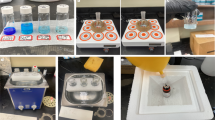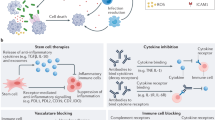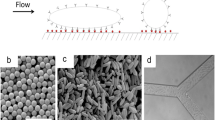Abstract
Intravenously injected nanopharmaceuticals, including PEGylated nanoparticles, induce adverse cardiopulmonary reactions in sensitive human subjects, and these reactions are highly reproducible in pigs. Although the underlying mechanisms are poorly understood, roles for both the complement system and reactive macrophages have been implicated. Here, we show the dominance and importance of robust pulmonary intravascular macrophage clearance of nanoparticles in mediating adverse cardiopulmonary distress in pigs irrespective of complement activation. Specifically, we show that delaying particle recognition by macrophages within the first few minutes of injection overcomes adverse reactions in pigs using two independent approaches. First, we changed the particle geometry from a spherical shape (which triggers cardiopulmonary distress) to either rod- or disk-shape morphology. Second, we physically adhered spheres to the surface of erythrocytes. These strategies, which are distinct from commonly leveraged stealth engineering approaches such as nanoparticle surface functionalization with poly(ethylene glycol) and/or immunological modulators, prevent robust macrophage recognition, resulting in the reduction or mitigation of adverse cardiopulmonary distress associated with nanopharmaceutical administration.
This is a preview of subscription content, access via your institution
Access options
Access Nature and 54 other Nature Portfolio journals
Get Nature+, our best-value online-access subscription
$29.99 / 30 days
cancel any time
Subscribe to this journal
Receive 12 print issues and online access
$259.00 per year
only $21.58 per issue
Buy this article
- Purchase on Springer Link
- Instant access to full article PDF
Prices may be subject to local taxes which are calculated during checkout





Similar content being viewed by others
Change history
03 May 2017
In the version of this Article originally published the first author's middle name was misspelled. His name should have read Peter Popp Wibroe. This has been corrected in all versions of the Article.
References
Kattan, J . et al. Phase, I. Clinical trial and pharmacokinetic evaluation of doxorubicin carried by polyisohexylcyanoacrylate nanoparticles. Invest. New Drugs 10, 191–199 (1992).
Laing, R. B., Milne, L. J., Leen, C. L., Malcolm, G. P. & Steers, A. J. Anaphylactic reactions to liposomal amphotericin. Lancet 344, 682 (1994).
Uziely, B. et al. Liposomal doxorubicin: antitumor activity and unique toxicities during two complementary phase I studies. J. Clin. Oncol. 13, 1777–1785 (1995).
Moghimi, S. M., Wibroe, P. P., Helvig, S. Y., Farhangrazi, Z. S. & Hunter, A. C. Genomic perspectives in inter-individual adverse responses following nanomedicine administration: the way forward. Adv. Drug Deliver. Rev. 64, 1385–1393 (2012).
Szebeni, J. Complement activation-related pseudoallergy: a stress reaction in blood triggered by nanomedicines and biologicals. Mol. Immunol. 61, 163–173 (2014).
Kastl, S. P. et al. In human macrophages the complement component C5a induces the expression of oncostatin M via AP-1 activation. Arterioscler. Thromb. Vasc. Biol. 28, 498–503 (2008).
Woodruff, T. M., Nandakumar, K. S. & Tedesco, F. Inhibiting the C5–C5a receptor axis. Mol. Immunol. 48, 1631–1642 (2011).
Szebeni, J . et al. A porcine model of complement-mediated infusion reactions to drug carrier nanosystems and other medicines. Adv. Drug Deliv. Rev. 64, 1706–1716 (2012).
Szebeni, J. et al. Complement activation-related cardiac anaphylaxis in pigs: role of C5a anaphylatoxin and adenosine in liposome-induced abnormalities in ECG and heart function. Am. J. Physiol. Heart Circ. Physiol. 290, H1050–H1058 (2006).
Warner, A. E. Pulmonary intravascular macrophages. role in acute lung injury. Clin. Chest Med. 17, 125–135 (1996).
Schneberger, D., Aharonson-Raz, K. & Singh, B. Pulmonary intravascular macrophages and lung health: what are we missing? Am. J. Physiol. Lung Cell Mol. Physiol. 302, L498–L503 (2012).
Longworth, K. E., Westgate, A. M., Grady, M. K., Westcott, J. Y. & Staub, N. C. Development of pulmonary intravascular macrophage function in newborn lambs. J. Appl. Physiol. 73, 2608–2615 (1992).
Csukás, D., Urbanics, R., Wéber, G., Rosivall, L. & Szebeni, J. Pulmonary intravascular macrophages: prime suspects as cellular mediators of porcine CARPA. Eur. J. Nanomed. 7, 27–36 (2015).
Zhang, X . et al. Regulation of Toll-like receptor-mediated inflammatory response by complement in vivo. Blood 110, 228–236 (2007).
Moghimi, S. M. Complement propriety and conspiracy in nanomedicine: perspective and a hypothesis. Nucleic Acid Ther. 26, 67–72 (2016).
Keyes, J. W. Jr, Wilson, G. A. & Quinonest, J. D. An evaluation of lung uptake of colloid during liver imaging. J. Nucl. Med. 14, 687–691 (1973).
Imarisio, J. J. Liver scan showing intense lung uptake in neoplasia and infection. J. Nucl. Med. 16, 188–190 (1975).
Moghimi, S. M. et al. Complement activation cascade triggered by PEG-PL engineered nanomedicines and carbon nanotubes: the challenges ahead. J. Control. Release 146, 175–181 (2010).
Chanan-Khan, A. et al. Complement activation following first exposure to pegylated liposomal doxorubicin (Doxil): possible role in hypersensitivity reactions. Ann. Oncol. 14, 1430–1437 (2003).
Szebeni, J. et al. Liposome-induced complement activation and related cardiopulmonary distress in pigs: factors promoting reactogenicity of Doxil and AmBisome. Nanomedicine 8, 176–184 (2012).
Moghimi, S. M., Hamad, I., Andresen, T. L., Jorgensen, K. & Szebeni, J. Methylation of the phosphate oxygen moiety of phospholipid-methoxy(polyethylene glycol) conjugate prevents PEGylated liposome-mediated complement activation and anaphylatoxin production. FASEB J. 20, 2591–2593 (2006).
Andersen, A. J. et al. Single-walled carbon nanotube surface control of complement recognition and activation. ACS Nano. 7, 1108–1119 (2013).
Moghimi, S. M. & Murray, J. C. Poloxamer-188 revisited: a potentially valuable immune modulator? J. Natl Cancer Inst. 88, 766–768 (1996).
Laverman, P., Carstens, M. G., Storm, G. & Moghimi, S. M. Recognition and clearance of methoxypoly(ethyleneglycol)2000-grafted liposomes by macrophages with enhanced phagocytic capacity. Implications in experimental and clinical oncology. Biochim. Biophys. Acta 1526, 227–229 (2001).
Kolhar, P. et al. Using shape effects to target antibody-coated nanoparticles to lung and brain endothelium. Proc. Natl Acad. Sci. USA 110, 10753–10758 (2013).
Lu, Z. S., Qiao, Y., Zheng, X. T., Chan-Park, M. B. & Li, C. M. Effect of particle shape on phagocytosis of CdTe quantum dot–cystine composites. MedChemComm 1, 84–86 (2010).
Champion, J. A. & Mitragotri, S. Role of target geometry in phagocytosis. Proc. Natl Acad. Sci. USA 103, 4930–4934 (2006).
Geng, Y. et al. Shape effects of filaments versus spherical particles in flow and drug delivery. Nat. Nanotech. 2, 249–255 (2007).
Chambers, E. & Mitragotri, S. Prolonged circulation of large polymeric nanoparticles by non-covalent adsorption on erythrocytes. J. Control. Release 100, 111–119 (2004).
Anselmo, A. C. et al. Delivering nanoparticles to lungs while avoiding liver and spleen through adsorption on red blood cells. ACS Nano 7, 11129–11137 (2013).
Moghimi, S. M., Hunter, A. C. & Andresen, T. L. Factors controlling nanoparticle pharmacokinetics: an integrated analysis and perspective. Annu. Rev. Pharmacol. Toxicol. 52, 481–503 (2012).
Jansen, J. H., Hogasen, K. & Mollnes, T. E. Extensive complement activation in hereditary porcine membranoproliferative glomerulonephritis type II (porcine dense deposit disease). Am. J. Pathol. 143, 1356–1365 (1993).
Wibroe, P. P., Ahmadvand, D., Oghabian, M. A., Yaghmur, A. & Moghimi, S. M. An integrated assessment of morphology, size, and complement activation of the PEGylated liposomal doxorubicin products Doxil®, Caelyx®, DOXOrubicin, and SinaDoxosome. J. Control. Release 221, 1–8 (2016).
Hamad, I. et al. Distinct polymer architecture mediates switching of complement activation pathways at the nanosphere–serum interface: implications for stealth nanoparticle engineering. ACS Nano 4, 6629–6638 (2010).
Chen, F. et al. Complement proteins bind to nanoparticle protein corona and undergo dynamic exchange in vivo. Nat. Nanotech. http://dx.doi.org/10.1038/nnano.2016.269 (2016).
Montalescot, G . et al. Evaluation of thromboxane production and complement activation during myocardial ischemia in patients with angina pectoris. Circulation 84, 2054–2062 (1991).
Gaca, J. G. et al. Prevention of acute lung injury in swine: depletion of pulmonary intravascular macrophages using liposomal clodronate. J. Surg. Res. 112, 19–25 (2003).
Szebeni, J. et al. The role of complement activation in hypersensitivity to PEGylated liposomal doxorubicin (Doxil®). J. Liposome Res. 10, 467–481 (2000).
Sone, Y., Serikov, V. B. & Staub, N. C. Intravascular macrophage depletion attenuates endotoxin lung injury in anesthetized sheep. J. Appl. Physiol. 87, 1354–1359.
Decuzzi, P. et al. Size and shape effects in the biodistribution of intravascularly injected particles. J. Control. Release 141, 320–327 (2010).
Decuzzi, P., Lee, S., Bhushan, B. & Ferrari, M. A theoretical model for the margination of particles with blood vessels. Ann. Biomed. Eng. 33, 179–190 (2005).
Castells, M. Desensitization for drug allergy. Curr. Opin. Allergy Clin. Immunol. 6, 476–481 (2006).
Bugna, S . et al. Surprising lack of liposome-induced complement activation by artificial 1,3-diamidophospholipids in vitro. Nanomedicine 12, 845–849 (2016).
Moghimi, S. M. Recent developments in polymeric nanoparticle engineering and their applications in experimental and clinical oncology. Anticancer Agents Med. Chem. 6, 553–561 (2006).
Szebeni, J. et al. Hemodynamic changes induced by liposomes and liposome-encapsulated hemoglobin in pigs: a model of pseudollargic cardiopulmonary reactions to liposomes. Role of complement and inhibition by soluble CR1 and anti-C5a antibody. Circulation 99, 2302–2309 (1999).
Meszaros, T. et al. Factor H inhibits complement activation induced by liposomal and micellar drugs and the therapeutic antibody rituximab in vitro. Nanomedicine 12, 1023–1031 (2016).
Wu, Y. Q. et al. Protection of nonself surfaces from complement attack by factor H-binding peptides: implications for therapeutic medicine. J. Immunol. 186, 4269–4277 (2011).
Rodriguez, P. L. et al. Minimal ‘self’ peptides that inhibit phagocytic clearance and enhance delivery of nanoparticles. Science 339, 971–975 (2013).
Perry, J. L., Herlihy, K. P., Napier, M. E. & Desimone, J. M. PRINT: a novel platform toward shape and size specific nanoparticle theranostics. Acc. Chem. Res. 44, 990–998 (2011).
Mollnes, T. E. et al. Essential role of the C5a receptor in E coli-induced oxidative burst and phagocytosis revealed by a novel lepirudin-based human whole blood model of inflammation. Blood 100, 1869–1877 (2002).
Bergseth, G. et al. An international serum standard for application in assays to detect human complement activation products. Mol. Immunol. 56, 232–239 (2013).
Acknowledgements
S.M.M. acknowledges financial support by the Danish Agency for Science, Technology and Innovation (Det Strategiske Forskningsråd), reference 09-065746. T.E.M. acknowledges financial support from the European Community's Seventh Framework Programme under grant agreement no. 602699 (DIREKT). S.M. acknowledges support from the National Institutes of Health (R01HL129179). The authors thank N. Payemi (University of Copenhagen) for assisting with scanning electron microscopy studies and H. Biotech for providing the pig C5a ELISA kit.
Author information
Authors and Affiliations
Contributions
S.M.M. and P.P.W. conceived the idea. P.P.W., A.C.A., P.H.N., A.S., V.G., R.U. and S.M.M. performed experiments. All authors designed, analysed and discussed data. P.P.W. and S.M.M. wrote the paper, with contributions from all authors. All co-authors critically revised the manuscript.
Corresponding author
Ethics declarations
Competing interests
The authors declare no competing financial interests.
Supplementary information
Supplementary information
Supplementary information (PDF 657 kb)
Rights and permissions
About this article
Cite this article
Wibroe, P., Anselmo, A., Nilsson, P. et al. Bypassing adverse injection reactions to nanoparticles through shape modification and attachment to erythrocytes. Nature Nanotech 12, 589–594 (2017). https://doi.org/10.1038/nnano.2017.47
Received:
Accepted:
Published:
Issue Date:
DOI: https://doi.org/10.1038/nnano.2017.47
This article is cited by
-
High biocompatible FITC-conjugated silica nanoparticles for cell labeling in both in vitro and in vivo models
Scientific Reports (2024)
-
Nanoscale anisotropy for biomedical applications
Nature Reviews Bioengineering (2024)
-
Nucleic acid drug vectors for diagnosis and treatment of brain diseases
Signal Transduction and Targeted Therapy (2023)
-
Controlling the biodistribution and clearance of nanomedicines
Nature Reviews Bioengineering (2023)
-
Cholesterol removal improves performance of a model biomimetic system to co-deliver a photothermal agent and a STING agonist for cancer immunotherapy
Nature Communications (2023)



